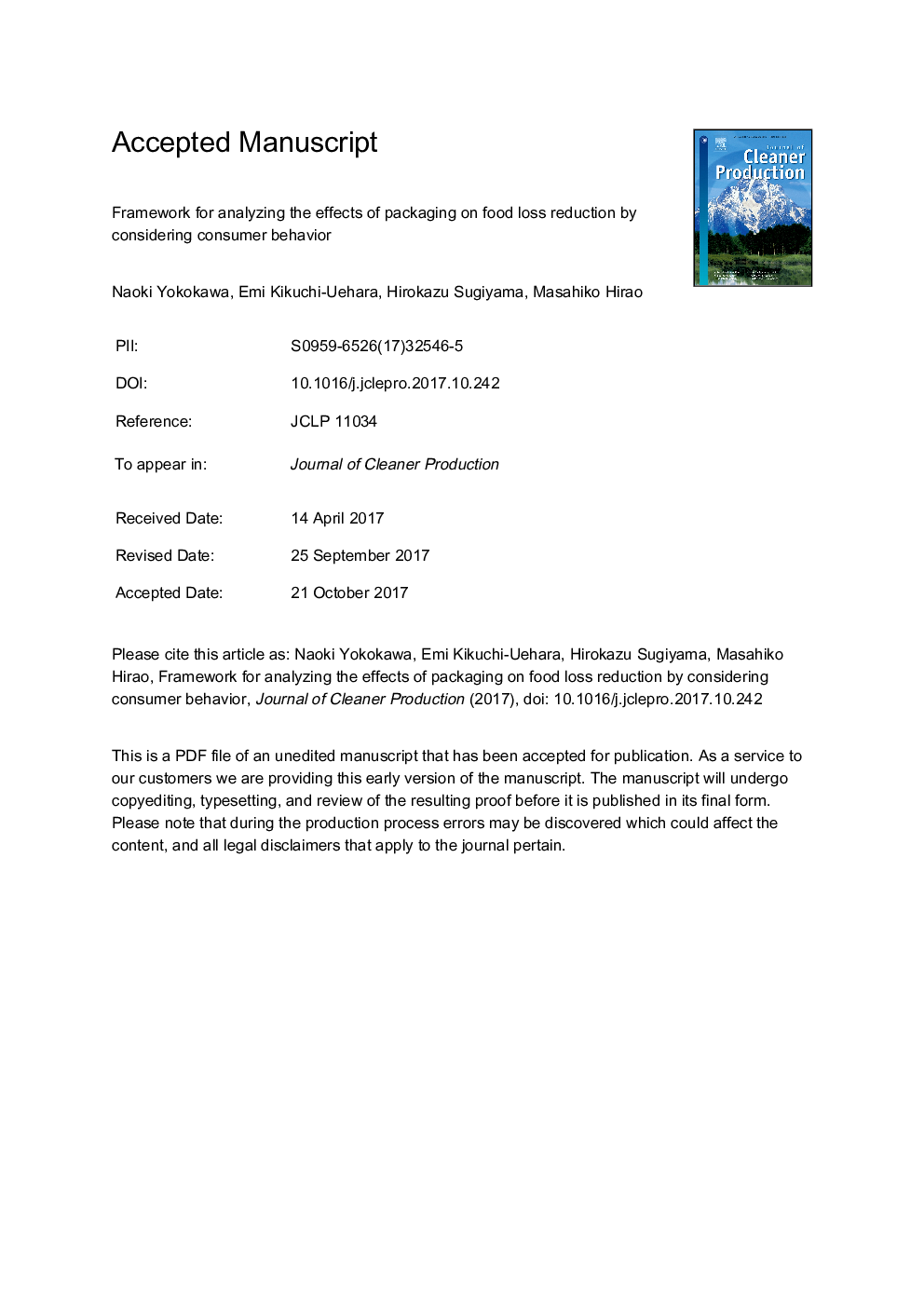| کد مقاله | کد نشریه | سال انتشار | مقاله انگلیسی | نسخه تمام متن |
|---|---|---|---|---|
| 8099276 | 1522079 | 2018 | 35 صفحه PDF | دانلود رایگان |
عنوان انگلیسی مقاله ISI
Framework for analyzing the effects of packaging on food loss reduction by considering consumer behavior
ترجمه فارسی عنوان
چارچوبی برای تحلیل تاثیر بسته بندی بر کاهش میزان غذا با توجه به رفتار مصرف کننده
دانلود مقاله + سفارش ترجمه
دانلود مقاله ISI انگلیسی
رایگان برای ایرانیان
کلمات کلیدی
ارزیابی چرخه حیات، بسته بندی، زباله های مواد غذایی، طراحی محصول، تجزیه و تحلیل سناریو، تاریخ انقضا،
ترجمه چکیده
در این مطالعه، ما یک چارچوب برای تجزیه و تحلیل اثرات بسته بندی بسیار کاربردی بر کاهش از دست دادن غذا را با در نظر گرفتن رفتار مصرف کننده ایجاد کردیم. چارچوب شامل دو تحلیل است. اولین تجزیه و تحلیل آماری است که تعیین کننده تعادل بین تأثیرات ناشی از بسته بندی بسیار کارکرده شده و کاهش اثرات مرتبط با کاهش کاهش وزن است. یک شاخص جدید، میزان بی نظمی از دست دادن مواد غذایی، به منظور تعیین حداقل کاهش ضرر غذایی مورد نیاز برای بهبود چرخه زندگی چرخه اثرات زیست محیطی مرتبط با تولید بسته بندی بسیار کاربردی تعریف شده است. دومین تجزیه و تحلیل سناریوی رفتار مصرف کننده برای ارزیابی تغییرات در تأثیرات محیطی ناشی از شیوه زندگی و ترجیحات مصرف مواد غذایی مصرف کنندگان است. برای بررسی اثربخشی چارچوب، ما یک مطالعه موردی از محصولات ژامبون عرضه شده در ژاپن را انجام دادیم. در این مورد، دو عملکرد بالا برای کاهش حجم محتوای محصول و افزایش تاریخ انقضا محصول در مقایسه با بسته بندی متعارف انتخاب شدند. نتیجه نشان داد که عملکرد بالا باعث کاهش تلفات غذایی در بعضی از سناریوها شده است که مردم مقدار کمی مصرف می کنند و پس از تاریخ انقضا، مواد غذایی را از بین می برند. به عنوان یک نتیجه از کاهش میزان غذا، به جز سناریویی که کاهش کاهش وزن در آن کمتر از نرخ برابری محاسبه شده از دست دادن مواد غذایی بود، تاثیرات محیطی چرخه زیست محیطی کاهش یافت. بنابراین، چارچوب می تواند اثرات بسته بندی بر روی تلفات غذایی و اثرات زیست محیطی برای رفتار مصرف کننده مختلف را ارزیابی کند. مطالعه موردی اثربخشی چارچوب را برای حمایت از طراحی و برنامه ریزی بسته بندی مواد غذایی برای کاهش اثرات زیست محیطی و تلفات غذایی نشان داد.
موضوعات مرتبط
مهندسی و علوم پایه
مهندسی انرژی
انرژی های تجدید پذیر، توسعه پایدار و محیط زیست
چکیده انگلیسی
In this study, we developed a framework to analyze the effects of highly functionalized packaging on food loss reduction by considering consumer behavior. The framework consists of two analyses. The first is a trade-off analysis to identify the balance between increased impacts caused by highly functionalized packaging and reduced impacts associated with food loss reduction. A novel indicator, the break-even rate of food loss, is defined to quantify the minimum food loss reduction required to recover the life cycle environmental impacts associated with the production of highly functionalized packaging. The second is a consumer behavior scenario analysis to evaluate variations in environmental impacts caused by the lifestyle and food consumption preferences of consumers. To verify the effectiveness of the framework, we conducted a case study of ham products marketed in Japan. In this case, two high functionalizations were selected to be reducing the product content volume and extending the product expiration date, compared with those of conventional packaging. The result indicated that high functionalization reduced food losses for some scenarios where people consume small quantities and discard food after the expiration date. Life cycle environmental impacts decreased as a result of food loss reduction except for the scenario where the food loss reduction was less than the calculated break-even rate of food loss. Thus, the framework can evaluate the effects of packaging on the food losses and environmental impacts for different consumer behaviors. The case study demonstrated the effectiveness of the framework to support the design and planning of food packaging for the reduction of environmental impacts and food losses.
ناشر
Database: Elsevier - ScienceDirect (ساینس دایرکت)
Journal: Journal of Cleaner Production - Volume 174, 10 February 2018, Pages 26-34
Journal: Journal of Cleaner Production - Volume 174, 10 February 2018, Pages 26-34
نویسندگان
Naoki Yokokawa, Emi Kikuchi-Uehara, Hirokazu Sugiyama, Masahiko Hirao,
